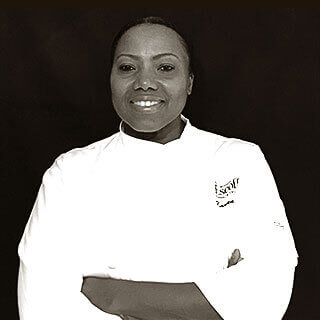Did you know that the easiest and least expensive way to promote your restaurant is on social media?
That’s right! The platforms you use to stay in touch with your friends and family can serve as a great place to promote your restaurant to new customers. Through hashtags, tagged locations, and engaging content creation, you can increase your revenue and grow awareness of your restaurant.
According to Pew research, 72 percent of Americans use at least one social media platform—and that number rises to over 80 percent for those under 50 years old. Odds are, your customers are part of that crowd, making social media a wonderful place to reach them—announcing restaurant promotions, showing off your dishes, and expressing the atmosphere of your restaurant.
We’ve gathered some excellent examples of social media marketing for restaurants to give you ideas to use for your own restaurant, bakery, food truck, or other culinary-based business.
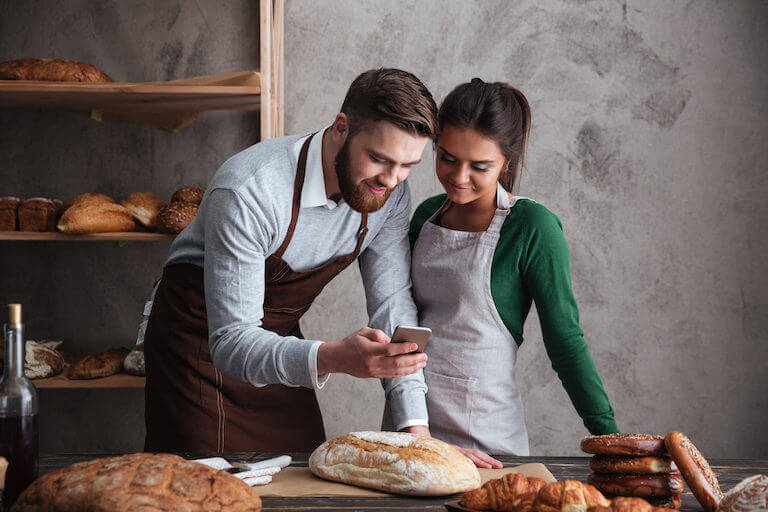
As a restaurateur, sharing photos of your food, your restaurant—or even yourself and your staff—can help you reach your desired customers.
Benefits of Using Social Media for Restaurants
Why should you start using social media to promote your restaurant?
The answer is simple—social media can increase your restaurant’s exposure to new customers.
When current customers come to your restaurant and post about their experience on their social media, they can tag your profile and check-in to your restaurant. These posts are essentially free promotion for you to a potential new audience.
The use of social media can also give you the opportunity to create a personality for your restaurant and brand. This can set you apart from every other restaurant in town and make you more personable.
More people are learning about new restaurants through social media. Industry reports have found that nearly half of consumers use social media to make a decision about where to eat. Through social media, they can read reviews, see photos of your restaurant and dishes, and help make their decision to eat there.
Social media can give restaurants a great opportunity to connect with customers. Through comments and reviews, restaurants can interact and respond to their patrons. This makes the customer feel special and valued by the restaurant, potentially increasing their chances of returning.
Voodoo Doughnuts regularly interacts with its customers on Instagram. With over 238,000 followers, they make a point to respond to comments and start a conversation with their followers.
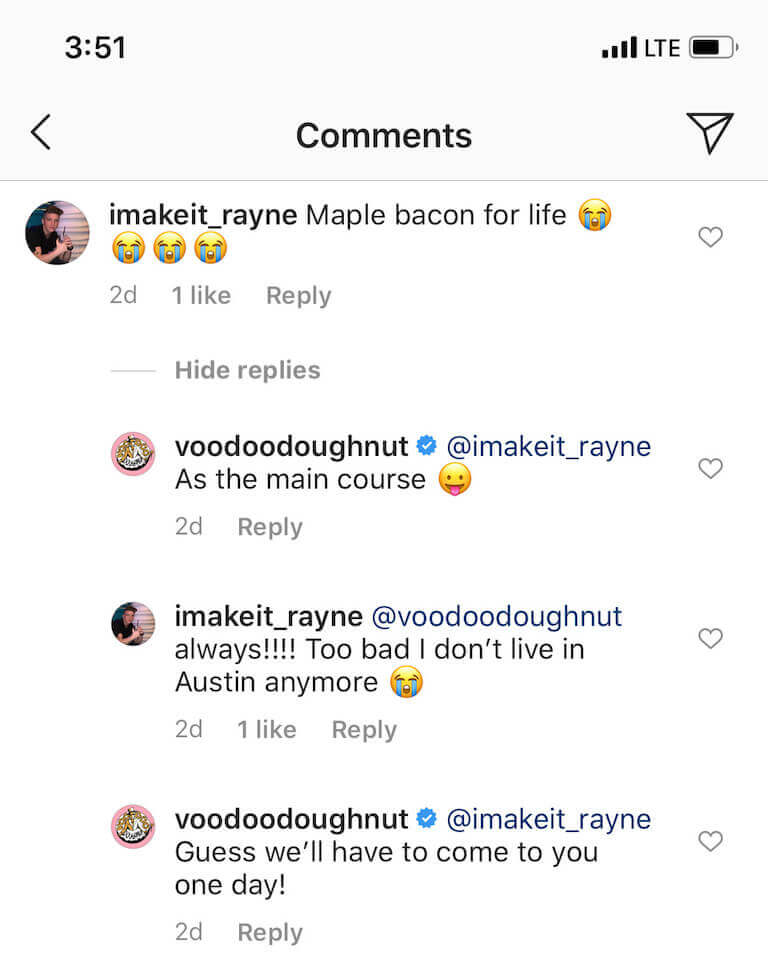
Social media can give restaurants the opportunity to directly engage with customers.
As you can see in this example, Voodoo Doughnuts picked one of the many comments on a post and responded to it. They showed their fun personality and made sure that the follower knew it wasn’t a canned response. Someone actually responded and even kept the conversation going.
Choose the Right Platforms
There are multiple platforms available to promote your restaurant on social media. The hardest part is determining which platform is right for you. Each platform offers a unique benefit and way to use it successfully.
Consider focusing on promoting your restaurant on one or two platforms instead of all of them. Managing a restaurant is a lot of work, you may not have time to promote it on every platform. Focusing on just one or two allows you to create the best content and effectively brand yourself.
However, note that you can always cross-post content to multiple platforms—for example, posting the same video clip on both Facebook and TikTok. This can allow you to maximize your reach with only minimal extra effort.
Always remember to fully complete your profiles with all updated information including hours, links to your website, and more.
Now, how do you choose the right social media platform to focus on?
Instagram is a photo-based social media platform that has nearly 1.3 billion monthly users. This platform can be perfect for restaurants who want to show off their dishes and have a knack for taking a good photo.
Through posts, reels, and stories, restaurants can share immediate updates such as tonight’s specials or limited-time promotions.
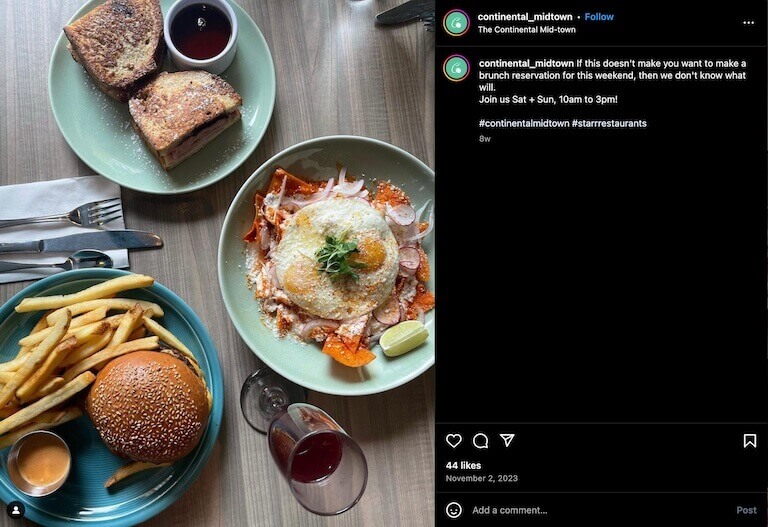
An image-oriented platform like Instagram can be a great venue to share food photos.
The Continental Mid-Town in Philadelphia uses their Instagram profile to show off dishes from their menu. The key to promoting your restaurant on Instagram is to have a pleasing aesthetic in your photos. This requires some content planning, photo editing, and design skills.
Facebook is one of the oldest social media sites around and is still very relevant today. When promoting your restaurant on Facebook, it’s important to know the difference between a profile and a business page.
A profile is for personal use. It’s where you share your vacation photos and chat with family and friends. A business page offers a space for you to put all of your restaurant’s information, and to access analytics as to who is visiting your page.
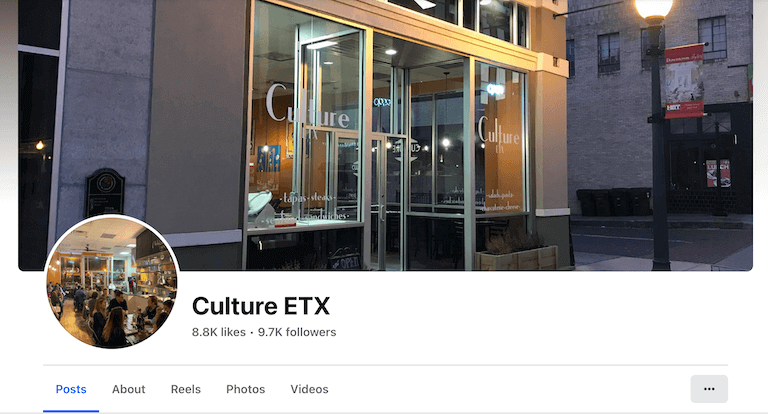
Online Culinary Arts Graduate, Executive Chef/Owner at Culture ETX, Food Network “Chopped” Contestant, Cochon 555 Competition Winner, & Military Veteran Lance McWhorter’s Culture ETX Facebook business page.
A Facebook business page is great for sharing photos, memes, videos, articles about or related to your restaurant, and promoting events your restaurant is hosting. Your page doesn’t necessarily have to be aesthetically pleasing like Instagram, so it’s easier to plan and create content for it.
X (Formerly Twitter)
X is more limited in its ability to promote your restaurant on social media, but when it’s done right you can gain a ton of exposure. Used for short text under 280 characters, photos, and videos less than two minutes long, X is for quick communication.
This platform does, however, offer a great space to connect with your customers. You can easily communicate and reply to your customers on X to keep them engaged.
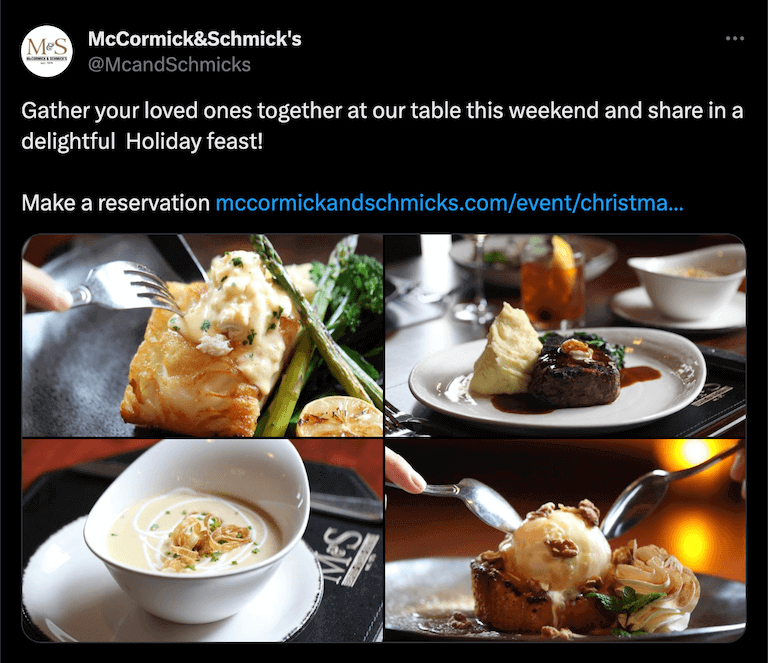
On X, a platform known for its text-based posts, food images can stand out.
McCormick & Schmick’s uses X perfectly to promote their restaurant, using short messages and attractive images in their posts.
TikTok
Launched in 2018, TikTok is the newest of these social media platforms—but it’s proven extremely popular, attracting more than 150 million monthly active users in America alone. Focused on short form video content, TikTok is great for posting “making of,” behind-the-scenes content or participating in memes and viral trends as a way of capturing your followers’ attention and showcasing your business’ food—and personality. Raw, authentic, “unproduced” content often works best on TikTok, meaning this can be a low-cost, yet highly effective platform for promoting your restaurant.
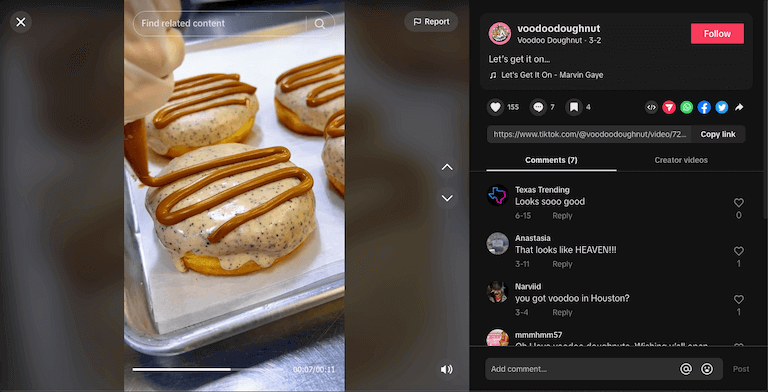
TikTok lends itself to catchy, bite-sized content meant to capture a viewer’s attention.
Here, Voodoo Doughnuts posted a short video of their doughnuts being decorated and set it to a well-known song. Not only does this show off their appetizing doughnuts, the catchy music and appealing presentation is likely to make the video stick in the viewer’s mind.
YouTube
YouTube can also be a great platform for connecting with your target audience. Longer video runtimes can allow you to create content with a higher production value, showcasing your restaurant in the best possible light. At the same time, you can also create Shorts, which function more like the short-form content of other platforms. And with community posts, memberships, and subscriptions, YouTube has become a bona fide social media platform of its own—creating the opportunity for restaurants to form real connections with their communities.
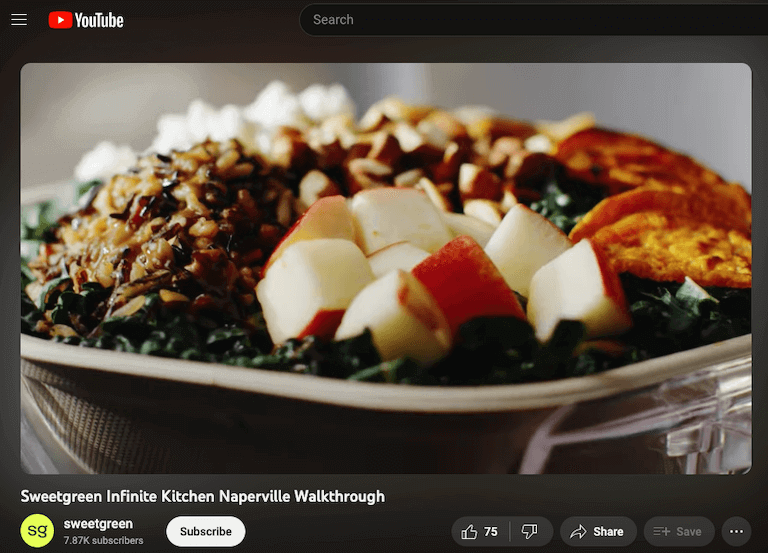
With longer video runtimes, YouTube gives restaurateurs the opportunity to tell a compelling story.
In this video, Sweetgreen presents a walkthrough of one of their new locations. The three-minute video is longer than content that might appear on other platforms, which gives the restaurant the opportunity to take their time showing off their amenities and menu offerings—creating a compelling reason for viewers to come in and visit.
Yelp
While Yelp isn’t considered a social media platform, it’s essential for every restaurant to have a complete profile on the website. Yelp is one of the most popular places people visit when searching for restaurants in their area. It’s a place to get information, read reviews, and see restaurant photos from both the owner and customers.
As a restaurant owner, you’ll likely want to pay attention to the reviews of your restaurant on Yelp, so you can consider feedback and improve your restaurant and services.
Create Engaging Content
Once you have decided which social media platforms are the best to promote your restaurant, it’s time to create engaging content.
What is engaging content?
It is content that drives your followers to engage with it, such as liking it, sharing it, and commenting on it. The more engagement your content receives, the more exposure your restaurant receives.
Creating this type of content requires some creativity and planning. So, we’ve taken some examples from restaurants, bakeries, and food trucks.
Share Staff Photos
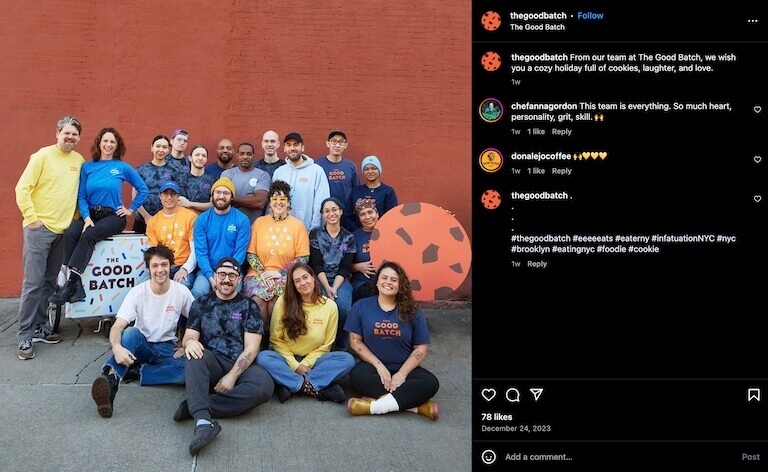
Staff photos can show off your restaurant’s personality and culture.
The Good Batch, a bakery in Brooklyn, shares a photo of their staff to show appreciation. Showing off their team humanizes the business, which can create a stronger connection with customers and give them a reason to keep coming back.
Behind the Scenes
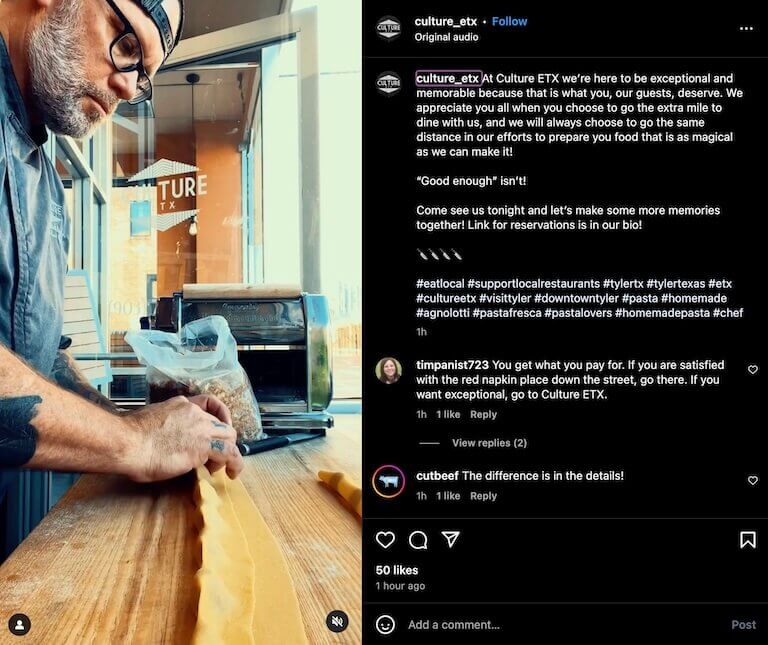
Behind-the-scenes photos can make your followers appreciate your process—and crave your cooking!
Culture ETX shares a photo from behind the scenes in the kitchen making fresh ravioli. Not only do followers get a sneak peek of this dish in the making, but the post also informs people of the care and labor that goes into preparing good food.
Foodie Photos
Show off photos of dishes on your menu. With excellent plating and presentation, it will surely entice your followers to come in and order a meal. It’s also a great way to promote new dishes and even your most popular ones.
News and Promotions
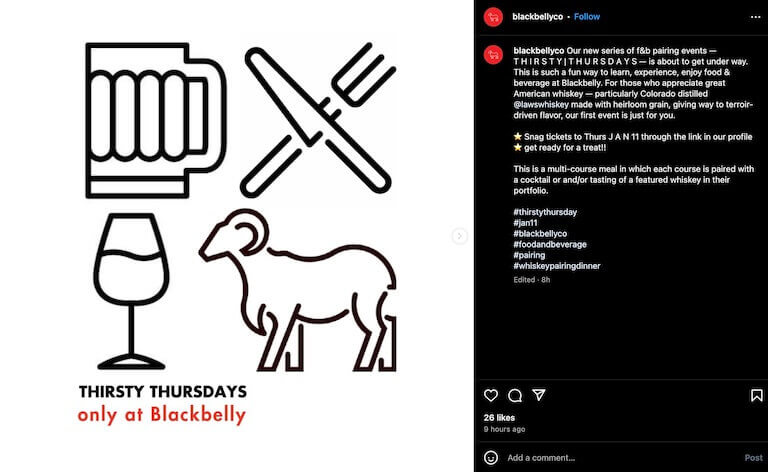
Social media can be a great way to share timely messages with followers.
Blackbelly shares graphics on Instagram to advertise special food and drink pairings and other promotions. They also use captions to show support for other local businesses and build excitement for this unique event.
Take Advantage of Trends

Tap into your customers’ enthusiasm for trends by incorporating them into your social media strategy.
Voodoo Doughnut posted the above image to coincide with the premiere of a reality TV show, tapping into the pop culture buzz. The image is not only attention-grabbing, but also reminds followers of the bakery’s wide selection.
Create Memes
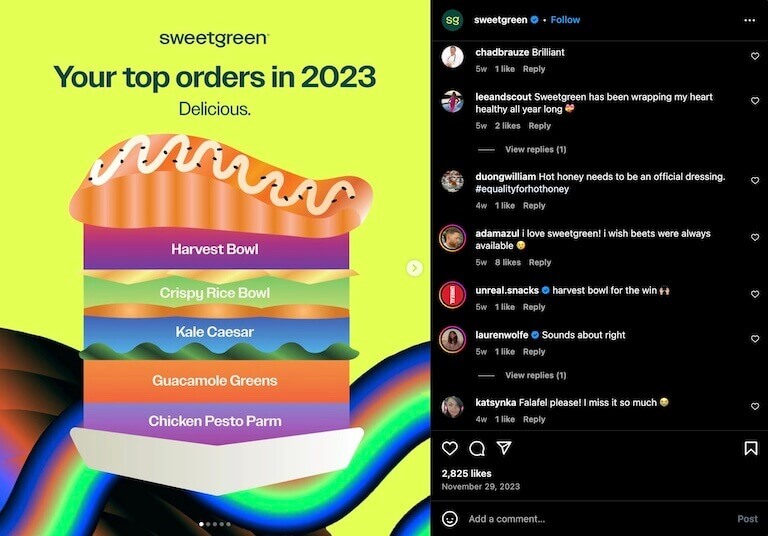
Memes capture people’s attention—you can take advantage of that by posting memes of your own!
Memes are always trending and present a great opportunity to promote your restaurant on social media. Sweetgreen makes some of their own memes and deploys them along with interactive posts like word searches to engage their audience.
Create an Editorial Calendar for Your Content
An efficient way to create engaging content for your restaurant’s social media is to plan an editorial calendar. This can keep you on track with your content and help you plan for promotions, holidays, and more.
An editorial calendar can also allow you to consider the time you publish a post. The timing of your posts can help you increase the number of customers that come to your restaurant.
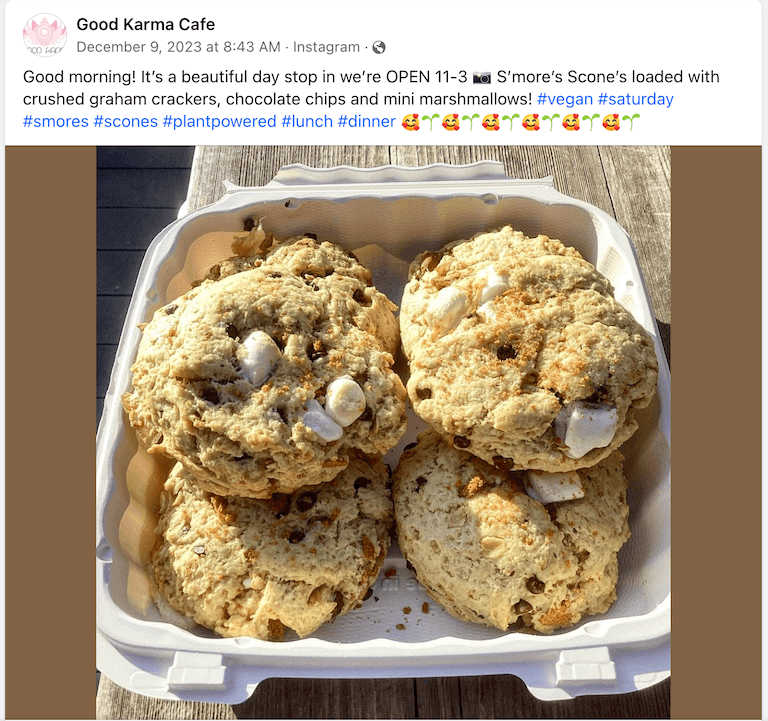
You can time your restaurant’s social media posts for maximum impact.
Good Karma Cafe in New Jersey has been known to post photos of their scones and other breakfast treats in the morning with captions like, “Good morning! It’s a beautiful day to stop in.” When a follower sees this on their timeline early on a Saturday morning, they may get the urge to head out and pick up a few scones of their own!
Host Social Media Contests
Boost your restaurant’s social media engagement and followers by hosting contests. Giving away something for free could turn your followers into customers.
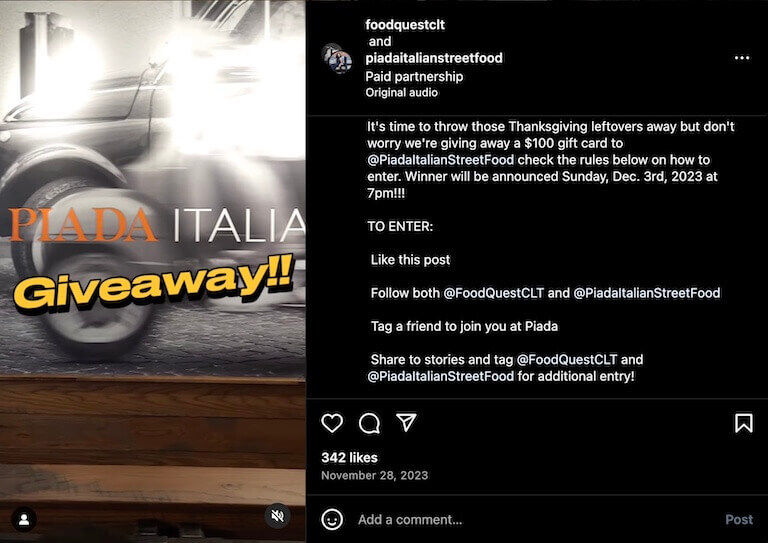
Contests can be a great way to incentivize followers to engage with your content.
Piada Italian Street Food uses Instagram posts to advertise the details of promotions giving away things like a $100 gift card. These posts work well because they require people to follow their profile and tag a friend in the comments, which will boost exposure and engagement.
Some ideas of social media contests you can run include a free happy hour, free cocktail with dinner, Valentine’s Day dinner for two, or free dessert for a lifetime.
Encourage User-Generated Content
If there is one thing people love to post on social media, it’s the food they are eating. When a customer posts about your restaurant and the food you serve, that is free promotion—especially when they tag your profile or use your hashtag.
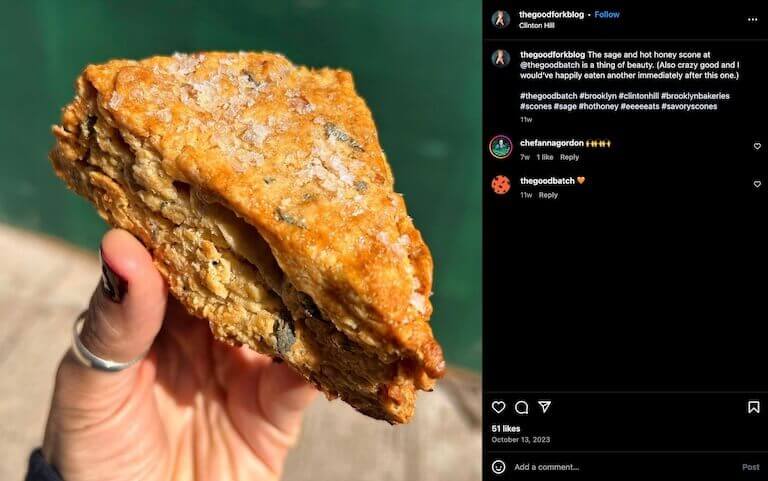
Restaurants can incentivize customers to tag the restaurant in their posts, boosting the reach of your business.
One customer was so excited about her fresh scone from The Good Batch that she just had to share it on social media. So, she used the restaurant’s hashtag #thegoodbatch and tagged the location in her post.
To encourage your customers to post about your restaurant, bakery, or food truck, you could offer a promotion or discount. For example, if a customer posts a photo on Instagram and tags your business, they can receive 10% off their meal. This can increase your exposure and help you gain followers.
Take your social media game up a notch and repost your patrons’ content. This can make your customers feel special because they have added value to your social media, potentially increasing the chances of them coming to your restaurant again.
Creativity is Endless
Social media is forever changing, but these basics could help you improve the way you promote your restaurant on these platforms. It’s important to be as creative as possible when generating content and marketing your business. Don’t be afraid to test the waters and really get to know what type of content your audience enjoys.
Managing a restaurant requires a lot of different skills, especially outside of the kitchen. From marketing to foodservice accounting to management, the Auguste Escoffier School of Culinary Arts has programs covering these topics. With comprehensive courses taught by professional and experienced Chef Instructors, you could gain the knowledge you need to successfully manage a restaurant.
Escoffier offers affordable** online programs with industry externships for anyone who wants to make a career change or begin their culinary journey.
Request more information about Escoffier’s programs, financing options, and career assistance today.
IF YOU LIKED THIS ARTICLE, READ THESE FOOD ENTREPRENEURSHIP ARTICLES NEXT:
- Should Your Restaurant Run a Loyalty Program?
- How to Calculate Food Cost Percentage
- Restaurant Management 101: An Essential Guide
This article was originally published on December 8, 2020, and has since been updated.
*Information may not reflect every student’s experience. Results and outcomes may be based on several factors, such as geographical region or previous experience.
**Consider your situation and resources to determine what is affordable and on budget, for you.

